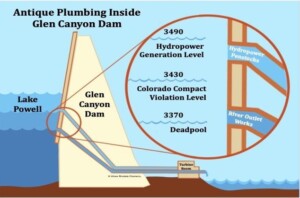Bureau’s Colorado River Experiment Demonstrates Magnitude of Water Crisis at Glen Canyon Dam
Archaic Design of Glen Canyon Dam Plumbing jeopardizes water supply for 30 million people in California, Arizona, Nevada, requiring urgent need to solve this problem during the current 2026 water negotiations.
The Bureau of Reclamation unveiled disturbing new results of a recent water flow experiment conducted at Glen Canyon Dam which demonstrates a spectacular water crisis unfolding there which will impact millions of Americans.
“This experiment reveals that the archaic plumbing inside Utah’s Glen Canyon Dam is the most urgent water problem facing the 40 million people of the Colorado River Basin.” said Zach Frankel, the executive director of the Utah Rivers Council.
Lake Powell is only 32% full, despite the Colorado River Basin coming off a banner water year in 2023 — its largest runoff in over a decade. Lake Powell has declined because climate change has been shrinking Basin snowpacks and water users have not substantially reduced their water use. These snowpacks are the largest source of water for the rivers and reservoirs of the Basin.
As Lake Powell water levels drop, the dam’s internal plumbing problems – now proven by the Bureau’s experiment – creates a looming water delivery crisis that will impact residents of seven states and Mexico. The Bureau’s experiment involved using a seldom-used set of water tubes inside Glen Canyon Dam to temporarily boost environmental flows in the Grand Canyon and to determine if the tubes can be safely used to deliver Colorado River water past the dam at low reservoir levels.
“The Bureau has dilly dallied solving Glen Canyon Dam’s plumbing problems long enough,” said Kyle Roerink, Executive Director of the Great Basin Water Network. “This urgent problem needs to be solved ASAP during the current Interim Guideline process.”
Water currently flows downstream from Lake Powell past Glen Canyon Dam through hydropower penstocks, which are the primary means of getting water out of the reservoir. As Lake Powell water levels drop, these hydropower tubes can no longer be used to deliver water through the dam because they are too high up in the water column.
“Glen Canyon Dam’s antique plumbing will soon jeopardize the water supply for 30 million people downstream and the Grand Canyon” said Eric Balken, the executive director of Glen Canyon institute. “If we drop everything to solve it, the solution will still take 10 years to implement — so why are we procrastinating?”
A smaller set of tubes, called the River Outlet Works, are the only means of releasing water through the Grand Canyon and to downstream users when Lake Powell water levels drop below 3489 feet above sea level. The Bureau’s recent experiment tested the use of these River Outlet Works and found that “cavitation” of the tubes was occurring – meaning that the water flows were damaging their structure. The tubes were not designed to be operated at low reservoir levels, and structural damage would impede their ability for sustained use.

Above: The plumbing system inside Glen Canyon Dam was designed in the 1950’s and isn’t capable of delivering enough water to the populous states of California, Nevada and Arizona once water levels begin to drop below 3,490 feet above sea level.
Read more about it here.
Falling water levels in Lake Powell, America’s second-largest reservoir, are making this design flaw a crisis for 30 million people downstream. Last year the reservoir came within 30 feet of the dam having to solely rely on these River Outlet Works. As the climate crisis puts more pressure on the reservoir, there is a growing threat to water deliveries to California, Arizona and Nevada, the Lower Basin states. If the reservoir drops below the hydropower penstocks, there is a point where not enough water could physically be released through the dam to meet the water delivery obligations of the 1922 Colorado River Compact. With the Outlet Works compromised, this delivery problem could occur much sooner than previously expected.
The failure to meet the water delivery obligations will have major impacts on water supplies in the Lower Basin states, but it will also have impacts on the Upper Basin states of Utah, New Mexico, Colorado and Wyoming. Lower Basin states could incite litigation, demand water from Upper Basin reservoirs, and force curtailment of Upper Basin usage. This would have economic impacts on Upper Basin communities ranging from reduced agricultural production, limited urban growth, and restricted recreation opportunities.
In two recent supplemental environmental reviews, the Bureau of Reclamation failed to consider Glen Canyon Dam’s antique plumbing problems. As the Bureau of Reclamation prepares for an upcoming environmental review for management of Lakes Powell and Mead — known as the re-consultation of the Interim Guidelines — the Bureau has an opportunity to change its course and analyze the dam’s risks before the 2026 deadline comes to pass.
For Information Call
801-631-2774 Eric Balkan; 702-324-9662 Kyle Roerink; 801-699-1856 Zach Frankel
